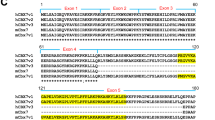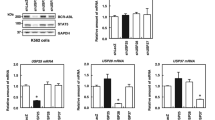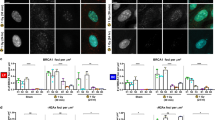Abstract
BRCA1, a familial breast and ovarian cancer susceptibility gene encodes nuclear phosphoproteins that function as tumor suppressors in human breast cancer cells. Previously, we have shown that overexpression of a BRCA1 splice variant BRCA1a accelerates apoptosis in human breast cancer cells. In an attempt to determine whether the subcellular localization of BRCA1 is cell cycle regulated, we have studied the subcellular distribution of BRCA1 in asynchronous and growth arrested normal, breast and ovarian cancer cells using different BRCA1 antibodies by immunofluorescence and immunohistochemical staining. Upon serum starvation of NIH3T3, some breast and ovarian cancer cells, most of the BRCA1 protein redistributed to the nucleus revealing a new type of regulation that may modulate the activity of BRCA1 gene. We have also characterized two new variant BRCA1 proteins (BRCA1a/p110 and BRCA1b/p100) which are phosphoproteins containing phosphotyrosine. Immunofluorescence and Western blotting analysis indicate cytoplasmic and nuclear localization of BRCA1a and BRCA1b proteins. To elucidate the biological function of BRCA1, we created a bacterial fusion protein of glutathione-transferase (GST) and BRCA1 zinc finger domain and detected two cellular proteins with molecular weights of approximately 32 and 65 kD, one of which contains phosphotyrosine designated p32 and p65 BRCA1 interacting proteins (BIP) that specifically interact with BRCA1. Western blot analysis of BIP with cyclins/CDKs and E2F antisera indicated association with cdc2, cdk2, cdk4, cyclin B, cyclin D, cyclin A and E2F-4 but not with cdk3, cdk5, cdk6, E2F-1, E2F-2, E2F-3, E2F-5 and cyclin E. Furthermore, we have also demonstrated a direct interaction of in vitro translated BRCA1a and BRCA1b proteins with recombinant cyclin A, cyclin B1, cyclin D1, cdc2, cdk2 and E2F fusion proteins in vitro. Taken together these results seem to suggest that BRCA1 could be an important negative regulator of cell cycle that functions through interaction with E2F transcriptional factors and phosphorylation by cyclins/cdk complexes with the zinc ring finger functioning as a major protein-protein interaction domain. If the interactions we observe in vitro is also seen in vivo then it may be possible that lack or impaired binding of the disrupted BRCA1 proteins to E2F, cyclins/CDKs in patients with mutations in the zinc finger domain could deprive the cell of an important mechanism for braking cell proliferation leading to the development of breast and ovarian cancers.
This is a preview of subscription content, access via your institution
Access options
Subscribe to this journal
Receive 50 print issues and online access
$259.00 per year
only $5.18 per issue
Buy this article
- Purchase on Springer Link
- Instant access to full article PDF
Prices may be subject to local taxes which are calculated during checkout
Similar content being viewed by others
Author information
Authors and Affiliations
Rights and permissions
About this article
Cite this article
Wang, H., Shao, N., Ding, Q. et al. BRCA1 proteins are transported to the nucleus in the absence of serum and splice variants BRCA1a, BRCA1b are tyrosine phosphoproteins that associate with E2F, cyclins and cyclin dependent kinases. Oncogene 15, 143–157 (1997). https://doi.org/10.1038/sj.onc.1201252
Received:
Revised:
Accepted:
Issue Date:
DOI: https://doi.org/10.1038/sj.onc.1201252
Keywords
This article is cited by
-
Cyclin B1 stability is increased by interaction with BRCA1, and its overexpression suppresses the progression of BRCA1-associated mammary tumors
Experimental & Molecular Medicine (2018)
-
BRCA1 and BARD1 colocalize mainly in the cytoplasm of breast cancer tumors, and their isoforms show differential expression
Breast Cancer Research and Treatment (2015)
-
Suppression of BRCA1 sensitizes cells to proteasome inhibitors
Cell Death & Disease (2014)
-
Research progress on the relationship between BRCA1 and hereditary breast cancer
The Chinese-German Journal of Clinical Oncology (2013)
-
c-Kit is required for growth and survival of the cells of origin of Brca1-mutation-associated breast cancer
Oncogene (2012)



